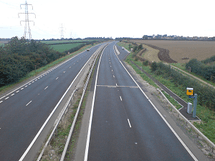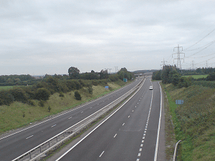A1079 road
The A1079 is a major road in Northern England. It links the cities of York and Kingston upon Hull, both in Yorkshire.
| |
|---|---|
| Major junctions | |
| From | Kingston upon Hull |
| To | York |
| Location | |
| Primary destinations | Beverley |
| Road network | |


Route
The road begins in central York, heading east initially as Lawrence Street and then Hull Road. After 2 miles (3.2 km) it meets the A64 at the congested grade separated Grimston Bar roundabout and gains primary status. Continuing as Hull Road it passes the villages of Dunnington and Kexby, before heading into the East Riding of Yorkshire and passing Wilberfoss, Barmby Moor and the small town of Pocklington. A roundabout at Pocklington Industrial Estate was constructed in 2011. After going through the village of Hayton the road becomes a dual carriageway for 1.5 miles (2.4 km), at the end of which is Shiptonthorpe, where the road becomes York Road. It meets the A614 (to Goole and Bridlington) at a roundabout, before bypassing the town of Market Weighton. The bypass was opened in 1991 - prior to this the road went through the town centre. The bypass was built with one roundabout, at the junction with the A1034. A second roundabout, at Holme Road, was constructed in 2014. The road then goes through the village of Bishop Burton before meeting the A1035 and A1174 at a roundabout west of Beverley at Killingwoldgraves.
The section from Killingwoldgraves roundabout to the northern outskirts of Hull is known as the Beverley Bypass; it passes around the southern side of Beverley, with a short dual carriageway section. The road crosses over the A164 (Beverley to Humber bridge) at a grade separated junction. It also bridges the Cottingham to Hull section of the Hull to Bridlington line, as well as the Cottingham to Dunwell road (Dunswell lane, underpassed). A new roundabout junction was constructed on the A1079 around 2011 for the Swift Leisure group caravan factory north of Cottingham, East Riding of Yorkshire.[1]
The Beverley Bypass section terminates at a roundabout junction (Dunswell roundabout) with the A1033 and A1174 road. Here the A1079 loses its primary status as it heads into the centre of Kingston upon Hull as Beverley Road and later, Ferensway.
The road terminates at the junction with the A63 (Hessle Road).
About the road
Much of the road is built to single carriageway standard, although a 1.1 miles (1.8 km) stretch of the Beverley bypass and a 1.5 miles (2.4 km) stretch near Shiptonthorpe are of dual carriageway standard. The majority of the road is national speed limit (60 mph / 97 km/h on single carriageway sections (including Market Weighton hill), 70 mph (110 km/h) / 113 km/h on dual carriageway sections). 13 Truvelo Speed Cameras enforce the speed limit along the stretch of the road between Kingston upon Hull and Market Weighton.
Following its de-trunking in 2003, the road is maintained by two authorities:
- East Riding of Yorkshire Council
- City of York Council
A road with an improving safety record
The road had a reputation for being dangerous, primarily because the majority of it is single carriageway. Cars therefore have to turn across oncoming traffic to access adjoining roads. Between 1999 and 2005, there was an average of 90 accidents per year . A local campaign group 'Action - Access - A1079' propose that in the long-term, more of the road be made dual carriageway to help combat these problems.
In the European Road Assessment Programme (EuroRAP) survey, which gives all major roads in Europe a safety rating, the A1079 is categorised as 'Medium-high risk' between Market Weighton and Hull, and 'Low-medium risk' between York and Market Weighton . The Market Weighton-Hull section was also identified in a EuroRAP report in June 2007 as being one of the 10 most dangerous roads in the UK, with 69 fatal or serious collisions between 2003 and 2005 . More recently the A1079 has had a better safety record, now being identified in the EuroRAP Results 2016 (covering the period from 2012-2014) as 'Low-Medium' risk for the section between York and Market Weighton, and 'Medium' risk between Market Weighton and Hull.
References
- "Boundary Business Park" (PDF). Met Engineers Ltd. Retrieved 7 June 2012.
External links
| Wikimedia Commons has media related to A1079 road (England). |
